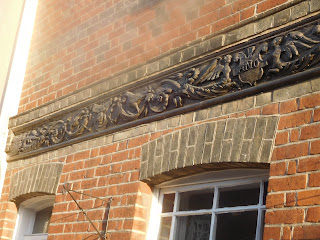1881 and 1891 censuses - East Street.
Newspaper headlines in 1881 featured the opening of the Natural History Museum in London, British defeats in the first Boer War, the start of the Fenian bombing campaign and a pitched battle between the Salvation Army and the Licensed Victuallers at which the Riot Act was read. The Census taken on 3rd April of that year revealed that two-thirds of the population lived in towns, one seventh in London alone.
In East Street the census recorded two hundred and eleven individuals, only sixty-six of whom were sixteen or under. This is a significant drop from previous years.Out of the sixty-eight households thirty-nine were headed by someone over forty.
Women's Work
Seventeen women and girls were employed as servants. Only four were recorded as lace-makers, a huge contrast to the days where all young teenage girls were tambourers. Similarly the trade of silk throwing has gone, with only four silk weavers left in East Street, none of them female.
Engine driving
Five men gave their occupation as "Engine Driver". This did not of course mean that they were driving trains, although they could have been. Much more likely they were operating steam driven engines used in agriculture. Skilled trades feature heavily as before, as do retail trades of various kinds: greengrocer, ironmonger, woollen draper. A number of white-collar professions were represented: Registrar of Births/deaths, sergeant of police, baker's clerk. Starting his career, living as a lodger in East Street, was the Master of the Boys' National School who would only retire in 1919 after forty-two years' service.
1891
In early March 1991 a violent storm hit Cornwall killing two hundred people and six thousand animals. It left snowdrifts fifteen feet high and wrecked ships along the coastline. The first Sherlock Holmes story was published, a telephone line was established between London and Paris and pneumatic tyres were developed for bicycles. The 1891 census showed that more than half the population now lived in cities of more than twenty thousand people.
In East Street two hundred and forty-two residents were recorded, seventy-two of them sixteen or younger.
Women's Work
The days of the expansion of the silk throwing and weaving industries were long past. Manufacturing clothing in factories had begun to replace dress-making as employment for women. Often very specialised tasks were recorded eg apron-finishing. Only three lace-makers remained. Twenty-nine women were employed as servants, perhaps reflecting an ageing population or possibly suggesting a rise in middle-class occupations. The range of opportunities for women was still extremely limited.
Male Occupations followed traditional patterns, although the number of labourers, agricultural or general had declined. Work related to horse transport was still much in evidence: groom, farrier, harness-maker, saddler. At the Post Office there was now a telegraph clerk.
A curious feature, revealing the strong Non-Conformist presence in Coggeshall, was the number of clergy: the Baptist Minister, the Congregational Minister, a lay preacher who also worked at the gas works , and two clerks in Holy Orders.



Comments
Post a Comment